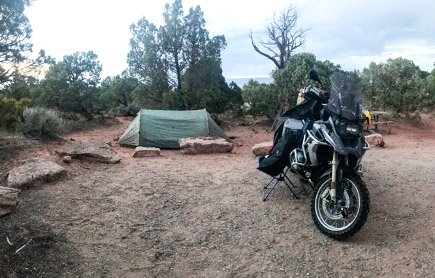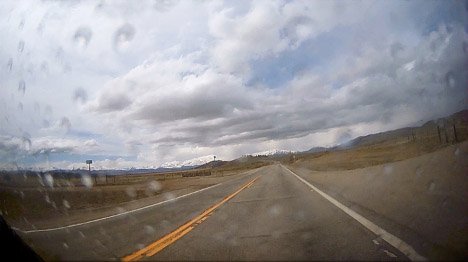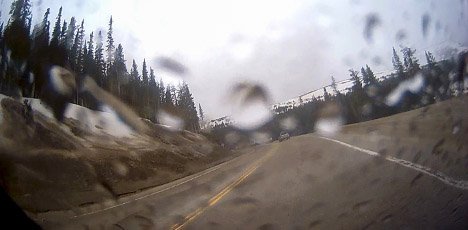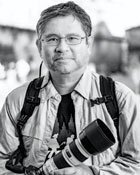Queasy Rider: My Tribute to America
/I was confused. I shrugged and asked, “What’s going on?”
“There’s a tornado coming!” he shouted back.
“Oh, damn,” I quickly evaluated the situation, ready to take the correct action. Off in the distance, I saw very dark and angry clouds with plumes twirling underneath them.
Front+Back Riding in a storm + cloud plumes (Photo by James Sobredo)
Riding in a massive rainstorm in Nebraska. This was what my HD camera was recording through my motorcycle windshield. This storm became too dangerous, and I exited at the first opportunity. (Photo by James Sobredo)
I was filming these cloud plumes twirl, and I was completely fascinated. Then it hit me: If these clouds became tornadoes, I was in major danger. When the winds picked up and became even stronger, I stopped filming and quickly ran and sought shelter in the brick building of the Rest Stop. (Photo by James Sobredo)
It was mid-afternoon on the second week of riding my motorcycle across America. Earlier that morning, I left Wyoming on my BMW GS motorcycle. I had seen the dark looming rain clouds in the horizon for miles. Then, when I reached Nebraska, I was battling extremely high winds that soon brought pouring rains, very dark skies, making visibility extremely difficult.
Then the thunderstorms came. I could see the skies flash with lightning. And soon I was riding in a pelting hailstorm. The falling hail gave a constant “ping, ping, ping” sound as it bounced off my motorcycle face shield and helmet. The hail hitting my motorcycle jacket and pants felt like tiny BB gun bullets were being shot at me.
Oddly, I was only slightly scared, but also excited. This was, after all, why I love long-distance adventure travel: It is about going on long journeys to faraway places, seeing a world that is different than mine, and experiencing new challenges. I took comfort in knowing I was riding in the top-of-the line Gortex motorcycle gear: jacket; pants; gloves and boots. I was completely dry and warm.
But I was also keenly aware at how dangerous the road conditions have become. Visibility was now highly compromised. I was not worried about me crashing. I was more worried about other cars not seeing me and possibly running or turning into me.
After 20 minutes of riding in the pouring rainstorm, I knew that safety dictated I get off the high-speed freeway. I must exit at the next rest stop or safe off-ramp and wait out the storm. This constant rain and wet, cold weather in the Midwest were in sharp contrast to the drought and extreme hot temperatures in California.
Earlier in May, I started my motorcycle trip across America in Sausalito.
Starting my “Tribute to America” motorcycle trip by taking an iconic photo by the Golden Gate Bridge in Sausalito, my second home in the San Francisco Bay Area. (Photo by James Sobredo)
Finishing final preparations in Stockton. But all did not go well, and I had to delay my trip by one day. Next morning, BMW is now a fully loaded motorcycle and ready to go. (Photo by James Sobredo)
Riding on the “Loneliest Road in America,” Highway 50 through Nevada was a pleasant break. Almost no cars behind me for nearly three hours. Enjoyed a beautiful sunset behind my shoulders as I rode to my motel. (Photo by James Sobredo)
My original plan was to split my time sleeping in motels and in campgrounds. But 2021 turned out to be the year where five times the number of Americans were traveling compared to the previous coronavirus pandemic 2020 year. I was warned by others that many campgrounds were full. It was in the middle of the week, so I knew that I had a chance to get a camp site if I went mid-week and at a less traveled campground. The state park campground was full in Grand Junction, so I made a run for the Colorado National Monument Park, which was a bit more difficult to get to.
Camping out in the Colorado National Monument. My original plan was to split my journey between motels (especially when the weather was bad) and campground. Turns out I rode in a massive rainstorm that was with me for nearly 70 percent of my trip. This was one of the rare moments when there was no rain. (Photo by James Sobredo
Iconic canyons at the Colorado National Monument Park. It was a harrowing experience riding to the camp ground. The roads wound along very steep cliffs that had no fence or barriers in many areas. Any mistake and your vehicle would fall thousands of feet straight down leading to fatal consequences. I was quite tense riding on those roads. (Photo by James Sobredo)
I drove up along the mountain roads that were perched precariously close to the edge, with steep drops and cliffs that had no protective barriers. The road was appropriately named “Rimrock” Drive. Any mistake would plunge me thousands of feet straight down to my unwelcome demise. I drove slowly … following very carefully the posted 15-mph speed limit. All my senses were focused on driving as safely as possible. All my motorcycle skills and training kicked into gear. This was not the time to let fear paralyze your senses. A mistake here could lead to fatal consequences.
The next day, I made a run for the RawHyde Adventure Camp, an official BMW Training Center for adventure motorcyclists. I was one day ahead of schedule so there was no rush. But then I was confronted with a challenge which would be my most dangerous experience on the road: The winds were blowing so strong that I had a difficult time keeping the motorcycle upright. The wind was so loud that I thought my helmet was broken (it was not!). The noise had a numbing effect on me, and, to my horror, I was in danger of falling asleep, which is very fatal on a motorcycle! Thus, after only one-and-a-half hour of riding, I pulled over at the next rest stop.
“I couldn’t believe you were able to keep your motorcycle up,” the man in the RV said as we compared notes in the rest stop in the town of Parachute, Colorado. “I really thought you would be blown over by the wind.”
“Honestly,” I replied, “I am a bit shaken up. Those winds are damn dangerous. And the noise on my helmet was putting me to sleep.”
I found out he and his wife were from Texas, and they were on their way home after their vacation visiting national parks. He explained that even though he was on a heavy-duty truck pulling an RV, “I had a hard time keeping my RV on the road. The winds are so strong!”
For me this was the final confirmation that I was not riding any further for the day. I had made a promise to myself that if I were ever in a dangerous situation, I would stop riding. Wait out the danger and proceed only if it were safe. That day, it was very clearly not safe to proceed. Luckily, there were two motels that I could see from the rest stop. I looked them up on Google and Expedia and chose the nicer, more high-end Plaza Hotel. I deserve to rest in a nice place especially after what I had just endured!
After a relaxing day and good night’s rest, the next morning I packed my motorcycle gear and headed out to Hartsel, where the RawHyde Adventure Camp was located, high up on the Rocky Mountains at 10,000 feet elevation.
Less than one hour outside of Parachute, traffic came to a total standstill, which worried me. I really do not like sitting in traffic, which fortunately, I rarely ever do in California, where “lane splitting” for motorcyclists is legal: Motorcycles can ride between cars in slow traffic (“lane filtering”) and fast traffic (“lane splitting”). “Lane filtering” is legal in Europe and quite common in the Philippines. In nearly all other states—Montana and Utah are the only other exceptions—lane filtering is illegal, which means motorcycles have to sit in traffic, even if it is dangerously hot (at 100°F)!
We were diverted by Colorado Highway Patrol to rural roads, and I could see the accident: A truck and two cars crashed and fell into the Colorado River. There were two medevac helicopters on the road, their rotors twirling as they waited to transport people—a chilling reminder that these roads were very dangerous.
Climbing up Hoosier Pass, the highest elevation I would reach at nearly 12,000 feet, it was cold and there was snow on the ground. Hoosier Pass marked two major events on my trip: it was the highest elevation I reached, and it was also the coldest at 37°F. In sharp contrast, when I was riding home after reaching the East Coast, it was 108°F as we came near Reno, Nevada.
The highest elevation I reached was at Hoosier Pass, which is about 12,000 feet elevation. I did not know about it until a fellow BMW motorcyclist from Colorado brought that fact to my attention. All I remember was it was raining the entire time, and I was hoping the rain would not turn into snow. My motorcycle thermometer recorded 37°F, which was the coldest temperature I experienced on this trip across America. (Photos by James Sobredo)
The gravel road up to RawHyde Adventure Camp in the Rocky Mountains of Colorado was fun. There was a slight rain when I reached camp, but the forecast for the next day was blue skies. I was one of the volunteers chosen to prepare the Camp for training season. Our reward was a free tour package with the company and to go riding after our workdays. I was in “motorcycle heaven,” hanging out with the famous Jim Hyde (RawHyde company founder & owner) and his staff, as well as BMW GS motorcyclists who rode from as far as Seattle and Kansas to participate in the Camp. As I do every day, especially in these pandemic times, I took my oxygen level readings just before going to bed: 91 percent oxygen level. Not good. But also, not surprising given that the camp was located at the 10,000 feet elevation. Unfortunately, I had a difficult time sleeping. I had a restless night, as I thought of my former student who died of pulmonary edema.
I woke up early the next morning, just after sunrise, and walked around camp. The panoramic view of the snow-covered Rocky Mountains was breathtakingly beautiful. On my walk up the hill back towards camp, I noticed I had to take deep breaths to force myself to inhale more often. Breathing was definitely difficult at this high elevation. Just before breakfast, I again took my oxygen level reading: 87 percent. Not good. If this reading and number were at sea level, I would be heading out to urgent care or the emergency room. But, since I was at high elevation, it was not surprising. My hope was it would stabilize and go higher after I took my asthma meds, which is what I have done in the past when I hiked and climbed mountains at high elevation.
After breakfast, we were assigned into small work groups. I cleaned the bathrooms and showers and worked alongside with none other than Jim Hyde to fix a leaking toilet. Yes, the owner of the top BMW adventure off-road company in America also does the dirty jobs! Hyde is really a remarkable leader who leads by example.
Then we prepared the tents (luxury ones for “glamping”) and cleaned and prepared the cabins (these are shared accommodations with beds). We also prepared the huge water tanks that would hold water for the camp. I had no problems doing any of the tasks. No dizziness or nausea. No shortness of breath, but I noticed that I had to force myself to take deep breaths so I could “oxygenate.” After lunch, I knew I had to check my oxygen level, just to be on the absolute safe side. It was at 82 percent.
I immediately sought out our camp medic, a retired firefighter who now spent his life as a paid staff person riding a BMW GS motorcycle on guided tours around the world. I told him my situation, my asthma, and how I had been monitoring my oxygen levels. Given my low oxygen level readings, I explained that I was leaving camp to go to a lower elevation, so I could stabilize.
“James, I know you really want to be here,” he said, “but those levels are too low. And it is not worth risking your life.” He explained that going to lower elevation was the right decision. He also recommended that I buy a can of oxygen as soon as I reached Hartsel, the town with the only gas station for miles.
The camp medic, a retired firefighter, at the BMW off-road camp reminded me that our elevation was about 10,000 feet. Unfortunately, my oxygen level continued to go lower and when it reached 82%, I decided it was time to leave for safety purposes. No adventure is worth putting your life at risk. It is better to be safe, so you can “live and ride another day.” (Photo by James Sobredo)
The Colorado Rocky Mountains are absolutely beautiful. But, unfortunately, my body could not adjust to the high elevation. The BMW off-road camp I was at was about 10,000 feet elevation. Although I did not feel the classic signs of altitude sickness, my oximeter readings clearly showed that my lungs were having major problems. After consulting with the camp medic, I decided to leave and made hotel reservations at Glenwood Springs, a town at “only” 5,700 feet elevation. I am glad I can make rational decisions that prioritizes personal health and safety. (Photo by James Sobredo)
After my motorcycle was fully packed, my newly found friends at the RawHyde Camp wished me luck, bid me farewell and added, “See you at the BMW motorcycle national rally in Montana!”
One of my BMW friends, a realtor from Seattle, insisted, for safety reasons, to ride down the mountain with me, which was very kind of him. One of the important things I learned in backpacking and mountaineering was that most accidents happened while descending a mountain. Unfortunately, that almost happened to me.
It was raining while we were riding down from camp. I was riding “lead,” and following the GPS directions on a road I was completely not familiar with. As we were coming down on a curve on the gravel road, I put on my rear brakes. Gently but firmly, so I could intentionally skid, a normal motorcycle maneuver when riding off-road. To my horror, there was no skid. The motorcycle did not slow down at all, and I was now in major danger of riding off the gravel road and crashing!
I tried again. And still no skid.
Whisky, Tango, Foxtrot … what on earth was going on!
The motorcycle was now shaking in a classic “death wobble,” as I was fighting and struggling to keep it from running off the road. I was preparing for the crash as I expected the motorcycle to careen off the road on a downward curve. I remember thinking: At least I’m fully armored with safety gear, so I will most likely survive, but it will hurt, both physically and emotionally.
Then I remembered what my adventure off-road instructor and other off-road trainers said: The FRONT-BRAKES will work just as well in stopping a motorcycle when riding off-road.
I gently … and slowly … squeezed the front brakes. And the motorcycle finally slowed down, got out of its death wobble, stabilized, and came back under my control. I had just prevented my motorcycle from careening off the road!
I quickly looked down at my ABS indicator and noticed that I had not turned off my ABS brakes, which is important to do when riding off-road. This mistake was completely my fault. It was totally pilot error and not the motorcycle’s fault.
During my entire trip, riding in a thunder and hailstorm, and dodging tornadoes in Nebraska was my scariest moment. But almost crashing in the Colorado Rockies and at high elevation was the closest I came to an accident. After a minute or two, I came to a stop to collect myself and regain my concentration. I also turned off my ABS brakes. And I asked my Seattle friend to take the lead, so I could calm down and be more relaxed.
In sailing, I often do an assessment of what I did wrong and what I did right after a major incident that could have been a disaster. On this assessment, what I did WRONG were: I did not spend enough time acclimating to higher elevation and went too quickly from Sausalito “sea level” to Rocky Mountain high-altitude (10,000 feet); I was riding too fast down the mountain on gravel roads and in bad weather (it was raining); and I completely forgot to turn off my ABS brakes.
But I survived, and it is good to be kind to yourself and acknowledge what I also did correctly: I took daily and regular oxygen readings; I came down to lower elevation when I realized that my oxygen level readings were dangerously low; I did not act macho, and I agreed to have company while riding down the gravel road, a route I was not familiar with; I was in Enduro mode; I never panicked; I remembered my adventure off-road training to use the front brakes to stop the motorcycle; I slowly and gently squeezed the front brakes—if I had panicked and grabbed the front brakes, I would definitely have crashed; and I was able to calm down, gather my composure and regain my mental sharpness. And best of all I slowed down considerably afterwards in driving down from Camp.
The road where I almost “lost it” and crashed. Total pilot error on my part. I forgot to turn off my ABS brakes, and I should have driven considerably slower, given the slight rain and my physical condition. Luckily, I remembered my off-road adventure training lessons from my classes, and I was able to bring the motorcycle under control. This was closest thing to an accident in my entire trip. And for this I am truly thankful that I take motorcycle training classes, continue to train, and learn and grow from my mistakes.(Photo by James Sobredo)
When I reached Glenwood Springs, a tourist town at “only” 5,700 feet, famous for its hot springs, I checked into the Denver Hotel, which was turned out to be a very spacious, upscale, and expensive accommodation. After a quick shower, I walked downstairs to the restaurant next to the hotel. My reward for surviving the day and making the correct decision to leave Camp for lower elevation was a glass of pinot grigio with an excellent Mexican dinner. To my pleasant surprise, the waiter was a young Filipina on a worker visa in the United States.
Dining outdoors in the cool climate of the Rocky Mountains, I could hear the gentle sound of the Colorado River right across my hotel. Glenwood Springs is a popular vacation town, and people were out and about for the evening, strolling and chatting on the streets. I took a selfie of myself and my dinner with the pinot grigio and sent it home to my wife, Lu, who is always kept updated during my travels and of my location.
As soon as I reached my hotel room, I took my oximeter out of my First Aid kit, inserted my finger, and took my oxygen level.
The reading said 97% oxygen level. I slept well that evening.
After the Colorado Rockies, I enjoyed a brief respite from the strong winds and rain. I enjoyed this stretch of road and blue skies riding into western Wyoming. It is for moments like these that we go on long journeys and ride our motorcycles, despite the hardships and the dangers. (Photo by James Sobredo)
Postscript. An existential moment occurred when I taped my “Emergency Contact” (wife’s phone number and email) and medical information to my helmet and also on a card in my left-sleeve zippered compartment of my jacket, which has a universal “Medical/Contact Information” symbol that medics know to look for. It was at that moment that the motorcycle trip and adventure across America “became real.”
Medical emergency contact number written on my card is securely taped to my helmet. It is still there today and survived heavy rains, hailstorms and 108°F heat in the desert. I had to pause and take a deep breath after I completed this task. My wife Lu is also always informed of my travel itinerary. It is a simple task that all long-distance adventurers should remember to do. (Photo by James Sobredo)
Upcoming in Part II: Riding in the Midwest and the “Dragon Slayer” road in Eastern Kentucky and in the heart of Appalachia and Trump country, reaching the East Coast, and spending time with family in the Washington, D.C. area.
James Sobredo, Ph.D., is professor emeritus of Ethnic Studies at Sacramento State University. He is a journalist and documentary photographer who lives in Stockton and Sausalito.
More articles from James Sobredo


















